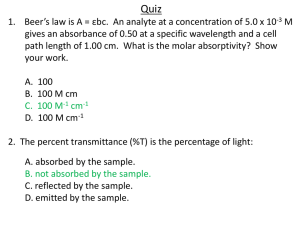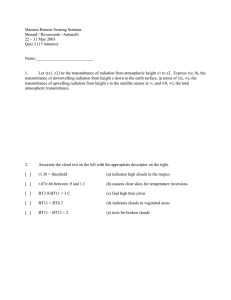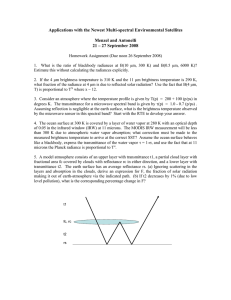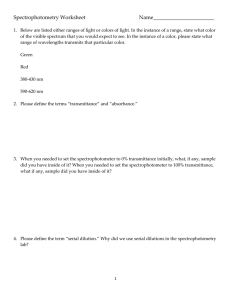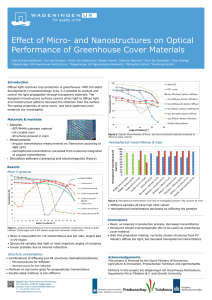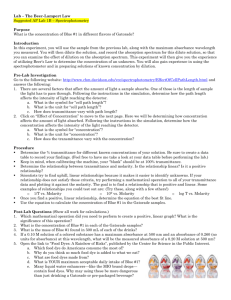Plastics for IrDA Data Transmission Windows
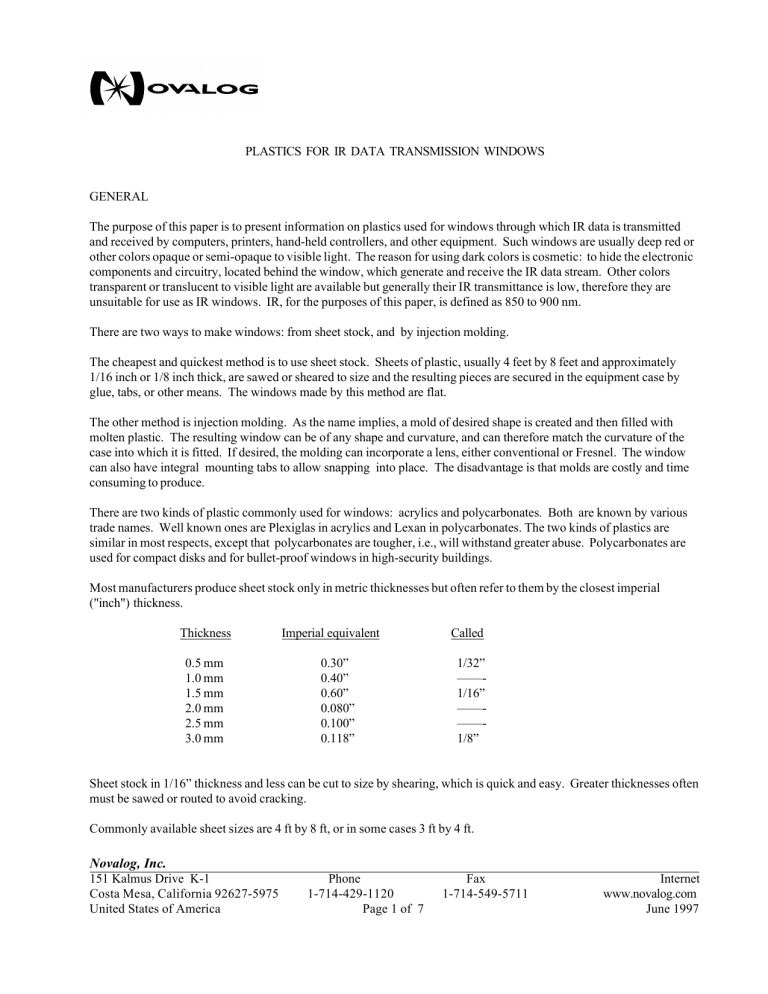
PLASTICS FOR IR DATA TRANSMISSION WINDOWS
GENERAL
The purpose of this paper is to present information on plastics used for windows through which IR data is transmitted and received by computers, printers, hand-held controllers, and other equipment. Such windows are usually deep red or other colors opaque or semi-opaque to visible light. The reason for using dark colors is cosmetic: to hide the electronic components and circuitry, located behind the window, which generate and receive the IR data stream. Other colors transparent or translucent to visible light are available but generally their IR transmittance is low, therefore they are unsuitable for use as IR windows. IR, for the purposes of this paper, is defined as 850 to 900 nm.
There are two ways to make windows: from sheet stock, and by injection molding.
The cheapest and quickest method is to use sheet stock. Sheets of plastic, usually 4 feet by 8 feet and approximately
1/16 inch or 1/8 inch thick, are sawed or sheared to size and the resulting pieces are secured in the equipment case by glue, tabs, or other means. The windows made by this method are flat.
The other method is injection molding. As the name implies, a mold of desired shape is created and then filled with molten plastic. The resulting window can be of any shape and curvature, and can therefore match the curvature of the case into which it is fitted. If desired, the molding can incorporate a lens, either conventional or Fresnel. The window can also have integral mounting tabs to allow snapping into place. The disadvantage is that molds are costly and time consuming to produce.
There are two kinds of plastic commonly used for windows: acrylics and polycarbonates. Both are known by various trade names. Well known ones are Plexiglas in acrylics and Lexan in polycarbonates. The two kinds of plastics are similar in most respects, except that polycarbonates are tougher, i.e., will withstand greater abuse. Polycarbonates are used for compact disks and for bullet-proof windows in high-security buildings.
Most manufacturers produce sheet stock only in metric thicknesses but often refer to them by the closest imperial
("inch") thickness.
Thickness Imperial equivalent Called
0.5 mm
1.0 mm
1.5 mm
2.0 mm
2.5 mm
3.0 mm
0.30”
0.40”
0.60”
0.080”
0.100”
0.118”
1/32”
——-
1/16”
——-
——-
1/8”
Sheet stock in 1/16” thickness and less can be cut to size by shearing, which is quick and easy. Greater thicknesses often must be sawed or routed to avoid cracking.
Commonly available sheet sizes are 4 ft by 8 ft, or in some cases 3 ft by 4 ft.
Novalog, Inc.
151 Kalmus Drive K-1 Phone Fax Internet
Costa Mesa, California 92627-5975 1-714-429-1120 1-714-549-5711 www.novalog.com
United States of America Page 1 of 7 June 1997
1
ACRYLICS
Colors are identified by number as well as name. The color number system which many companies use and which has become a defacto standard consists of four digits beginning with the number 2. As an example, the following table presents eight of the many “standard” colors available, along with selected characteristics:
TYPICAL ACRYLICS AND SELECTED CHARACTERISTICS
Color Color
Number Name
2025
2050
2064
2157
2404
2423
2711
None
black
blue
gray
red
bronze
red
deep red
colorless
Appearance semi opaque translucent transparent translucent transparent transparent semi opaque transparent
Typical IR
Transmittance (percent)
56
90
85-90
92
48
2
0
4
Note: The above transmittance values are for 0.118 inch thickness, equal to 3 mm. Transmittance varies inversely (logorithmically) proportional to thickness, therefore transmittance of thinner plastic is slightly greater, that of thicker plastic slightly less.
From this chart it can be seen that most acrylic colors attenuate IR to such an extent as to render them unsuitable for use as IR windows. Color numbers 2423 and 2711 transmit 85-90% of IR light and are the ones commonly used for this purpose (see transmittance curve for 2711at the back of this paper). If cosmetics is not a consideration, colorless plastic affords the highest IR transmittance. Color 2711 is a deep red that in reflected light appears black to the eye. It is produced specifically for use as IR windows and is often called an IR transmitting filter. The same material produced by
Cyro Industries is called color 1146-0. In addition to sheet stock, AtoHaas (formerly Rohm and Haas) produces acrylic injection molding pellets for use as IR transmission filters; the color number is 58015. (Companies mentioned in this paper are listed at the end of the text, with addresses and phone numbers.)
Some manufacturers have their own color numbering system but the colors of the plastic itself are generally identical to those of the industry “standard”, and the numbers can be translated.
Some common trade names for acrylics, listed with their manufacturer, are:
Acrycast
Acrylite
Plexiglas
Polycast
Calsak Corporation
Cyro Industries
AtoHaas
Polycast Technology Corporation
Some acrylics manufacturers produce both sheet stock and injection molding pellets, others sheet stock only.
POLYCARBONATES
In general, all the colors discussed above under Acrylics are available in polycarbonates, but most manufacturers use their own color number system rather than the 2000-series commonly used for acrylics. As with acrylics, most colors have low IR transmittance except for those specifically designed as IR transmitting filters.
Several manufacturers produce polycarbonates; three well known ones are Bayer, Dow, and General Electric.
2
Bayer
Bayer was formerly known as Miles, Inc.. One of their plastics suitable for producing IR windows is Makrolon 2405. It is available from Bayer in many colors but only in pellet form (no sheet stock). No IR transmittance values are available except for their color number 7881 which is specifically for IR filters and has an IR transmittance of approximately 90% (see transmittance curve). Color 7881 appears black in reflected light.
Dow
Dow recommends their Calibre 301 or 303 polycarbonate for IR windows. Various colors are available, including clear, blue, black, and ivory. Dow can provide no data on IR transmittance. Available from Dow only in pellet form, but several companies including Manchester Products and Spartec Plastics produce sheet stock using Dow pellets. These are available from distributors such as Cadillac and Regal.
General Electric
Lexan 9034, GE’s polycarbonate sheet stock, is available in several thicknesses and many colors. The following chart presents several Lexan 9034 colors and their approximate acrylic equivalents. As can be seen, acrylic colors that have high IR transmittance also have high IR transmittance in Lexan 9034, and acrylic colors that transmit low do the same in
Lexan 9034.
SELECTED COLORS OF LEXAN 9034 COMPARED TO ACRYLICS
Acrylic Approximate Lexan
Color Equivalent Color Description
Typical IR Transmittance (percent)
Acrylics Lexan
2025
2050
2064
2157
2404
2423
2711
No number
701
*
7113
6214
5109
612
*
112 black blue gray red semi opaque translucent transparent translucent bronze red transparent transparent deep red semi opaque colorless transparent
* No equivalent color.
Note 1.
Thickness 0.125”. Color number 71023 for 0.060” thickness.
Note 2.
Thickness 0.100”.
Note 3.
Thickness 0.060” or 0.125”.
Note 4.
Thickness 0.062”.
0
4
48
2
56
90
85-90
92
0
—
70
5
75
100
—
92
Note 1
Note 2
Note 3
Note 4
One of General Electric’s polycarbonates particularly suitable for use as IR windows is Lexan 121. This product is available only in injection molding pellets. Several IR transmission filter colors are available for Lexan 121; all are in shades of green and blue-violet which appear black in reflected light. All have cutoff wavelengths in the 600 to 700 nm region and all are suitable for use as IR windows. The color numbers are 21051, 21064, 21092, 21125, 21127, and
31142. The transmittance curve for 21051 is included at the back of this paper.
3
RESOURCES
AtoHaas Americas Inc. (manufacturer)
(Formerly Rohm and Haas)
Plastics Technology Center
P.O. Box 219
Bristol, Penna. 19007
800-217-3258
Bayer Corporation (manufacturer)
Polymers Division
9 Corporate Park Drive Suite 240
Irvine, Calif. 92714-5113
(714) 833-2351
Cadillac Plastic and Chemical Co. (distributor)
10801 Norwalk Blvd.
Santa Fe Springs, Calif. .90670
(310) 903-0197
Calsak Corporation (distributor)
200 W. Artesia Blvd.
Compton, Calif. 90220
800-743-2595
Cyro Industries (manufacturer)
25 Executive Blvd.
Orange, Conn. 06477
(203) 799-4066
The Dow Chemical Company (manufacturer)
2040 Dow Center
Midland, Mich. 48674
800-441-4369
General Electric Company (manufacturer)
One Plastics Ave
Pittsfield, Mass. 01201
800-845-0600
Manchester Products (manufacturer)
20401 Prairie St.
Chatsworth, Calif. 91311
(818) 886-9816
Plastic Sales Incorporated (distributor)
849 W. 18th St.
Costa Mesa, Calif. 92627
(714) 645-6860
Polycast Technology Corporation (manufacturer)
Acrylic Division
70 Carlisle Place
Stamford, Conn. 06902
800-243-9002
Regal Plastics (distributor)
14709 Spring Ave.
Santa Fe Springs, Calif. 90670-5107
(310) 404-4014
Spartec Plastics (manufacturer)
14263 Gannet St.
La Mirada, Calif. 90638
800-557-4338
Specialty Manufacturing Inc.
Paul Kennedy
6790 Nancy Ridge Dr.
San Diego, Calif. 92121
(619) 450-1591
800-491-1652
Has several sheets of Lexan IR transmitting filter for sale as surplus material.
4
TRANSMITTANCE CURVES
This section presents transmittance curves for selected plastics.
ACRYLIC COLOR NUMBER 2711
100
80
60
PERCENT
TRANSMITTANCE
40
20
0
700 800 900 1000
WAVELENGTH IN NANOMETERS
1100 1200
100
PERCENT
TRANSMITTANCE
90
80
70
700 800
PLEXIGLAS, CLEAR, 0.118" THICKNESS
900 1000 1100
WAVELENGTH IN NANOMETERS
5
1200 1300
MAKROLON 2405, COLOR NUMBER 7881
60
PERCENT
TRANSMITTANCE
40
100
80
20
0
400 600 800
WAVELENGTH IN NANOMETERS
1000 1200
60
PERCENT
TRANSMITTANCE
40
100
80
20
0
380 400 500
LEXAN 9034, COLOR NUMBER 112
600 700 800
WAVELENGTH IN NANOMETERS
6
900 1000
LEXAN, COLOR NUMBER 21051
100
80
60
PERCENT
TRANSMITTANCE
40
20
0
600 700 800
WAVELENGTH IN NANOMETERS
900 1000
Prepared by Richard Herman October 1996 Revised June 1997
7
